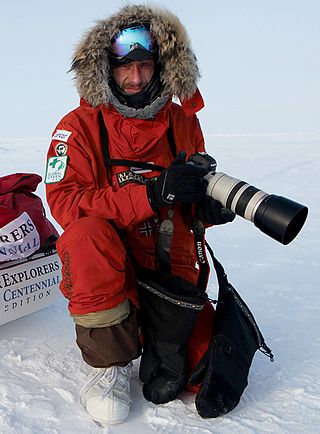
Roald Engelbregt Gravning Amundsen was a Norwegian explorer of polar regions. He was a key figure of the period known as the Heroic Age of Antarctic Exploration.

An ice shelf is a large floating platform of ice that forms where a glacier or ice sheet flows down to a coastline and onto the ocean surface. Ice shelves are only found in Antarctica, Greenland, Northern Canada, and the Russian Arctic. The boundary between the floating ice shelf and the anchor ice that feeds it is the grounding line. The thickness of ice shelves can range from about 100 m (330 ft) to 1,000 m (3,300 ft).

Børge Ousland is a Norwegian polar explorer. He was the first person to cross Antarctica solo.

Cecilie Skog is a Norwegian adventurer who trekked across Antarctica in 2010.
Benjamin John Saunders is an English polar explorer, endurance athlete, and motivational speaker. He led the first return journey to the South Pole on foot via Shackleton and Scott's route in 2013–14, and skied solo to the North Pole in 2004. Saunders has skied more than 3,700 miles (6,000 km) on polar expeditions since 2001. He holds the record for the longest human-powered polar journey in history (2,888 km) and for the longest solo Arctic journey by a Briton (1,032 km).

Liv Ragnheim Arnesen is a Norwegian educator, cross-country skier, adventurer, guide, and motivational speaker. Arnesen led the first unsupported women’s crossing of the Greenland Ice Cap in 1992. In 1994, she made international headlines becoming the first woman in the world to ski solo and unsupported to the South pole. – a 50-day expedition of 745 miles (1,200 km).
Rupert Nigel Pendrill Hadow known as Pen Hadow, is an Arctic region explorer, advocate, adventurer and guide. He is the only person to have trekked solo, and without resupply by third parties, from Canada to the Geographic North Pole.
Matty L McNair is an American explorer. She now lives in Iqaluit, Nunavut, Canada on Baffin Island, where she runs her company NorthWinds. Among her many accomplishments are:

The Explorer's Grand Slam is an adventurer goal to reach the North Pole and South Pole, as well as climb the Seven Summits.
Eric Philips OAM is an Australian polar explorer, adventurer and polar guide.

Sebastian Copeland is a British-American-French photographer, polar explorer, author, lecturer, and environmental advocate. He has led numerous expeditions in the polar regions to photograph and film endangered environments. In 2017, Copeland was named one of the world's top 25 adventurers of the last 25 years by Men's Journal. He is a fellow of The Explorers Club. His documentary Into the Cold was a featured selection at the 2010 Tribeca Film Festival and was released on DVD timed to Earth Day 2011.
Adrian Hayes is a British record-breaking polar explorer and adventurer, best known for reaching the three extreme points of the Earth—the Three Poles Challenge—which involved walking all the way to the North Pole, South Pole and summiting Mount Everest, all in the shortest period of time.
Lonnie Dupre is an American Arctic explorer whose achievements include the first Pacific to Atlantic winter traversal of the Northwest Passage by dog sled in 1991 and the first and only human-powered circumnavigation of Greenland, by dog sled and kayak, in 2001. In 2006, he also successfully executed the first human-powered summer expedition to the North Pole by sled and canoe, and would later return to the pole as part of the unsupported human-powered 2009 Peary-Henson Centennial Expedition.
Ryan Waters is an American mountaineer, mountaineering guide, and polar skiing guide.

Alain Hubert is a Belgian explorer. He is a certified mountain and polar guide, a civil engineer, and the founder President of the International Polar Foundation. With the Foundation and its private partners, he built and financed the construction of the scientific research station ‘Princess Elisabeth’. This station is the first ‘Zero Emissions’ station in Antarctica, designed under the spirit of the Madrid protocol system establishing in 1992 the strictest environmental rules to date for a continent through the Antarctic Treaty System.
John Huston is an American polar explorer, motivational speaker, wilderness guide, and safety and logistics consultant. In 2009, Huston completed the first successful unsupported American expedition to the North Pole. He has also completed expeditions to the South Pole, Greenland, and Ellesmere Island. Huston is the co-author of Forward: The First American Unsupported Expedition to the North Pole.










